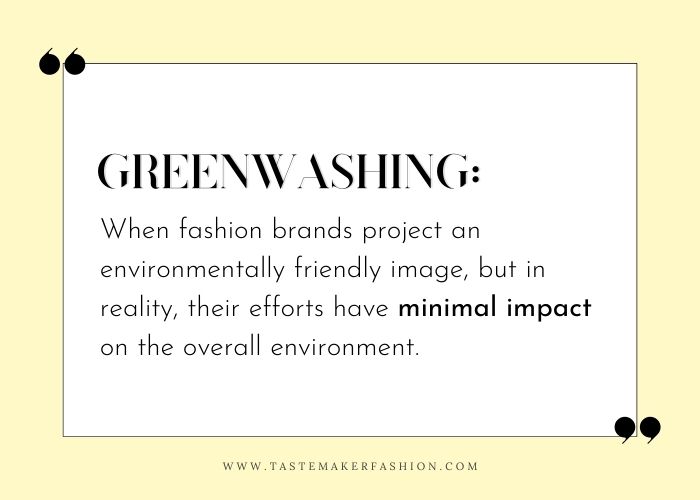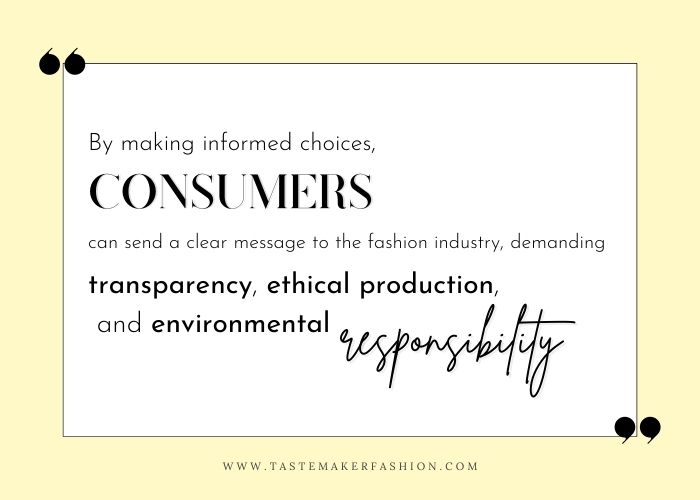
Ethical and sustainable fashion aren’t just buzzwords – they’re about taking real steps to cut down on the environmental and social impact of your clothes, from production to the end of their journey. Navigating the world of sustainability is trying to unravel a complicated knot, thanks to its intricate web of interconnected factors. And let’s face it, companies often fall short of complete transparency, making it hard for you to get the full picture.
Ethical and sustainable fashion can be tricky, and it’s okay to not have all the answers right away. However, by educating yourself about sustainability and changing the narrative, you’re taking the first step towards making informed choices and weaving eco-friendly practices into your life.
Practices that Define Ethical and Sustainable Fashion Brands
Sourcing Materials and Using Resources
Knowing where your clothes’ materials come from is a big deal. It’s important to prioritize ethical and sustainable material sourcing and consider the impact of resource utilization including water, energy, and chemicals. Companies should adopt systems that don’t mess up the environment or the communities involved.
Waste Management
Manufacturing clothing can get messy with water, chemicals, and excess materials. But companies shouldn’t just dump out the waste without a thought. Instead, they should handle their waste with responsibility like using closed-loop systems that recycle their water and chemicals to keep the production cycle going.
Transportation and Packaging
Do you ever think about the journey your clothes take from the factory to your closet? Whether it’s by planes, trains, or automobiles, it really does matter. And the packaging, too. It’s time for companies to think green by incorporating thought-out transportation plans and minimal, eco-friendly packaging.
Fair Labor and Wages
Ethical and sustainable fashion isn’t just about the planet; it’s about treating your workers right. Fair pay, safe workplaces, and decent working hours are non-negotiable. Let’s make sure our favorite fashion brands play fair from supply chain workers all the way up to corporate levels.
Diversity and Inclusivity
Sustainability makes sure everyone is getting a fair shot. This includes hiring people from different walks of life, from the factory floor right up to the big bosses. It also means representation for all, honest conversations, and building safe environments that work for everyone.
End-of-Life Responsibility
Clothes won’t last forever. So, companies need to own up to what happens when your jeans and tees retire. Using biodegradable materials that break down over time is a win. Or finding ways to give clothes a second chance through secondhand shopping or recycling programs.

Understanding the Impact of Greenwashing in Fashion Industry
Greenwashing in the fashion industry adds an extra layer to the complexity of the ethical and sustainable puzzle. This term refers to when fashion brands project an environmentally friendly image, but in reality, their efforts have minimal impact on the overall environment. It’s like putting a small bandaid on a significant wound, creating the illusion of sustainability without making any substantial change. It can be difficult to find brands that lay all their cards on the table, making it challenging for consumers to make informed choices.
H&M Conscious Choice Greenwashing
Take H&M, for example. They got called out for claiming that most of their clothes were eco-friendly in their “Conscious Choice” collection. While some items were made from recycled materials, the claim fell short when considering the bogus environmental clothing information H&M offered consumers. For example, one product page inaccurately stated that 30% less water was used, when, in fact, the reality was an increase of 30% in water consumption.
Moreover, their ethical and sustainable claims were further undermined as many of their garments continued to release microplastics into the water. This discrepancy raises concerns about the overall authenticity and effectiveness of H&M’s ethical and sustainable initiatives.
Zara Greenwashing
Similarly, Zara caught heat for a capsule collection with LanzaTech, featuring clothes made from polyester captured from carbon emissions. Nice try, but a single collection doesn’t outweigh the massive amount of clothing Zara overproduces annually. Rather than using limited-edition releases as a diversion, Zara could enhance its commitment to genuine sustainability by addressing core issues such as overproduction and poor working conditions.
The prevalence of greenwashing in the fashion industry not only obscures the true ethical and sustainable impact of clothing but also hinders consumer trust. As shoppers strive to make informed and ethical and sustainable choices, the industry must address these deceptive practices to foster genuine change and ensure a more transparent and responsible future for fashion.

Empowering Ethical and Sustainable Practices
The responsibility to lead ethical and sustainable change ultimately rests with the companies that will make the most difference. Brands must take the initiative and integrate sustainable practices into their production processes, from sourcing materials to end-of-life considerations.
However, consumers can command influence and stop fast fashion by “voting with their wallets”. By making informed choices and actively supporting brands committed to sustainable practices, consumers can send a clear message to the industry– demanding transparency, ethical production, and environmental responsibility. Our individual actions, choices, and demands can collectively shape the market, nudging companies toward more ethical and sustainable practices. Here is what you can do:
Educate Yourself
Engage in ongoing learning about the ethical and sustainable fashion industry, its impact on both your life, and on the overall environment. Learn about the most popular clothing fabrics and how they affect the environment. An informed consumer is a powerful force for positive change.
Define Your Personal Style
Discovering and embracing your signature personal style not only leads to a wardrobe that truly reflects you but also reduces the tendency to chase fleeting fashion trends. This shift minimizes waste and ensures your clothes remain timeless in your closet.
Slow Down Consumption
Practice slow shopping by giving yourself time to evaluate potential purchases. This ensures that every item you buy holds genuine value for you, reducing impulsive buys and unnecessary waste.
Prioritize Quality
Opt for clothes crafted from high-quality fabrics and meticulous garment construction. Choosing durable pieces ensures a longer lifespan for your garments, reducing the overall environmental impact.
Care for Your Clothes
Implement proper washing and maintenance practices to extend the longevity of your clothing. Caring for what you already own minimizes the need for frequent replacements and contributes to ethical and sustainable consumption.
Analyze at an Individual Level
Instead of relying solely on a brand’s overall sustainability claims, inspect each clothing piece individually. Not all items from a brand may align with ethical and sustainable practices, emphasizing the importance of assessing each purchase separately.
Support Genuine Sustainability
Direct your support (and your money) towards brands that are genuinely committed to sustainable practices. By investing in these brands, you actively contribute to a market that values ethical and sustainable principles.

Key Ethical and Sustainable Wardrobe Essentials
With the intricacies of achieving sustainability in every facet of the fashion industry and the potential confusion caused by greenwashing, consumers often find it challenging to understand the true impact of their choices. To start making better ethical and sustainable clothing choices, consider looking for the following:
Give Clothes a Second Life
Take a closer look inside your own closet to uncover hidden gems that can be creatively repurposed, breathing new life into your wardrobe with fresh and stylish looks. Foster a sense of community by engaging in clothing swaps with friends or participating in borrowing circles, providing both ethical and sustainable options for rotating your wardrobe.
Venture into local thrift stores, consignment shops, or explore online platforms such as Depop, ThredUp, or The Real Real to discover secondhand treasures with unique stories. For special occasions or trendy pieces, opt for renting services like Rent the Runway or Nuuly, offering ethical and sustainable alternatives for garments that may only be worn a few times.
It’s important to understand the downsides of thrifting when it comes to donating your clothes. When finding new homes for your clothes, try to seek out more direct avenues rather than dropping them off at donation centers. This ensures your clothes will go to someone who genuinely appreciates them.
Opt for Organic and Certified Clothing
Look for garments made from organic fabrics, especially those with certifications ensuring ethical production practices. Consider Textile Certifications such as the Global Organic Textile Standard (GOTS) or Fair Trade Organization which guarantees ethical and sustainable clothing sourcing, safe working conditions, and fair trade practices throughout the supply chain. It’s like having a stamp of approval for ethical and sustainable fashion.
Seek out Recycled Clothing
Find clothing made from recycled materials, particularly beneficial for items made from polyester or nylon, known for their durability but often associated with questionable production practices. Recycled polyester can cut emissions by an astounding 32% compared to its brand-new counterpart.
Now, here’s the fine print: right now, some recycled clothes are born from plastic bottles, diverting them from the well-established recycling systems. With fast fashion’s tendency to make one-and-done types of clothing, recycled fashion can potentially nudge these materials faster toward landfills. Plus, bear in mind that even recycled synthetics still shed microplastics during their time in the washing machine. While there are challenges, the pursuit of ethical and sustainable recycled clothing is still essential for a wardrobe that’s both eco-friendly and fashionable.
Embrace Lenzing Fabrics
Explore ethical and fabrics from the sustainable Lenzing group, an Austrian company known for sustainable cellulosic fibers sourced from wood pulp. These fabrics utilize environmentally safe chemicals and closed-loop systems, ensuring resources are efficiently recycled in the production cycle. Key fabrics include TENCEL Lyocell, Lyocell Filament, Refibra, and Ecovero, each offering unique benefits and sustainable production practices.
By embracing these steps, you can make informed choices, contributing to a more ethical and sustainable fashion industry.
Clothing To Skip for an Ethical and Sustainable Planet
As we navigate the path toward a more sustainable wardrobe, it’s crucial to identify the clothing choices that might do more harm than good. Here are some materials to steer clear of, considering their significant environmental impact:
Virgin Cotton
Despite its widespread use and wearability, virgin cotton poses substantial environmental challenges. Cotton cultivation guzzles 6% of the world’s pesticides and 16% of insecticides, leaving a catastrophic trail of toxic chemicals behind it. Further highlighting the environmental toll of virgin cotton, its excessive water use can be illustrated by the drastic depletion of the Aral Sea, which lost 85% of its volume due to cotton irrigation. Opting for alternatives such as organic and repurposed cotton can significantly mitigate the negative impacts associated with brand-new cotton.
Virgin Animal Products
Materials like wool, cashmere, silk, leather, and other animal-derived products are best reassessed, especially when there are many secondhand alternatives available. Unfortunately, the conditions for animals during the production of these materials are painful and the quality of life is poor, even if the animal is not directly killed.
Viscose / Rayon
Despite claims of sustainability due to its natural and decomposable sources, the production of viscose is far from it. It usually involves the use of toxic chemicals which dramatically affect the environment and local communities surrounding it. Its weak durability and dependency on dry cleaning make viscose a less-than-ideal choice for environmentally-conscious shoppers.
Acrylic
Considered a major player in microplastic pollution, acrylic is not the friendliest fabric. It unleashes almost 730,000 plastic particles with every wash, surpassing even its synthetic companions like polyester and nylon. The woes don’t stop there – its production relies on toxic chemicals, and its stubborn refusal to break down only intensifies its environmental footprint. When seeking eco-friendly alternatives, steering clear of acrylic is a wise move for a cleaner laundry routine and a healthier planet.
—
By incorporating these ethical and sustainable practices into our consumer behavior, we collectively exercise influence on the fashion industry. Remember, every ethical and sustainable choice you make contributes to the positive transformation of our fashion landscape.
